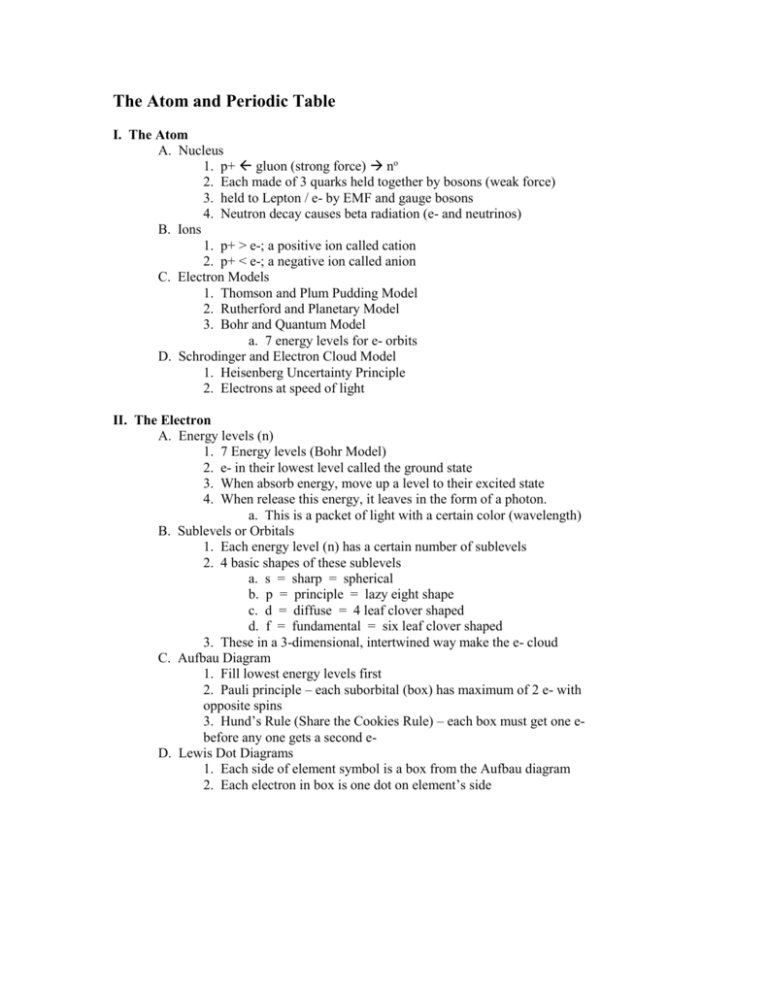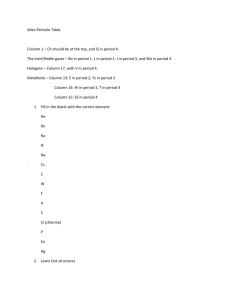The Atom, Etc.
advertisement

The Atom and Periodic Table I. The Atom A. Nucleus 1. p+ gluon (strong force) no 2. Each made of 3 quarks held together by bosons (weak force) 3. held to Lepton / e- by EMF and gauge bosons 4. Neutron decay causes beta radiation (e- and neutrinos) B. Ions 1. p+ > e-; a positive ion called cation 2. p+ < e-; a negative ion called anion C. Electron Models 1. Thomson and Plum Pudding Model 2. Rutherford and Planetary Model 3. Bohr and Quantum Model a. 7 energy levels for e- orbits D. Schrodinger and Electron Cloud Model 1. Heisenberg Uncertainty Principle 2. Electrons at speed of light II. The Electron A. Energy levels (n) 1. 7 Energy levels (Bohr Model) 2. e- in their lowest level called the ground state 3. When absorb energy, move up a level to their excited state 4. When release this energy, it leaves in the form of a photon. a. This is a packet of light with a certain color (wavelength) B. Sublevels or Orbitals 1. Each energy level (n) has a certain number of sublevels 2. 4 basic shapes of these sublevels a. s = sharp = spherical b. p = principle = lazy eight shape c. d = diffuse = 4 leaf clover shaped d. f = fundamental = six leaf clover shaped 3. These in a 3-dimensional, intertwined way make the e- cloud C. Aufbau Diagram 1. Fill lowest energy levels first 2. Pauli principle – each suborbital (box) has maximum of 2 e- with opposite spins 3. Hund’s Rule (Share the Cookies Rule) – each box must get one ebefore any one gets a second eD. Lewis Dot Diagrams 1. Each side of element symbol is a box from the Aufbau diagram 2. Each electron in box is one dot on element’s side III. Valence Orbitals / Blocks A. Valence e- are the outer most shell of electrons 1. Octet Rule – atoms want to have a complete/full valence shell a Groups I and II - s b B groups - d c Lanthanides and Actinides - f d Groups III through VIII - p IV Organizing the Elements – History A. Mendeleev – organized table by atomic weight B. Moseley – organized table by atomic number V. Table A. Periods are the rows and represent the energy level (n) of valence eB. Groups/Families are columns and have same # valence e- for A elements 1. 10 elements have symbols that don’t match the first letters of name C. Metals in A, and those in B are Transition Metals 1. Metals are to left of stair line (includes Al) 2. Lanthanides and Actinides are Transition Metals (Period 6 and 7) D. Nonmetals – to right of stair line (Halogens and Noble Gases) E. Metalloids – have side along stair line 1. Excludes Al F. Groups and Characteristics – KNOW THESE! Group I A. Alkali Metals (Group 1) - do not occur elementally in nature - have one valence electron, s block - have low ionization energies - form colorless ions, each with a +1 charge - are reactive metals obtained by reducing the +1 ions in their natural compounds - are stored under kerosene or other hydrocarbon solvent because they react with water vapor or oxygen in air - form water-soluble bases - are strong reducing agents - are good conductors of electricity and heat - are ductile, malleable, and soft enough to be cut with a knife - have a silvery luster, low density, and a low melting point II A. Alkaline Earth Metals (2) - do not occur elementally in nature - occur most commonly as carbonates, phosphates, silicates, and sulfates - occur naturally as compounds that are either insoluble or only slightly soluble in water - contain two valence electrons, s block - tend to lose two electrons per atom, forming ions with a +2 charge - are less reactive than alkali metals - primarily form ionic compounds - react with water to form bases and hydrogen gas - are good conductors of heat and electricity - are ductile and malleable - have a silvery luster - include the naturally radioactive element radium The B Groups. Transition Metals (3-12) - consist of metals in groups 3 through 12 - contain one or two valence electrons, in d or f blocks - are usually harder and more brittle than metals in groups 1 and 2 - have higher melting and boiling points that metals in groups 1 and 2 - are good conductors of heat and electricity - are malleable and ductile - have a silvery luster, except copper and gold - include radioactive elements 89 through 109 - include mercury, the only metal that is liquid at room temperature, and U #92, the last natural element - have chemical properties that tend to differ from each other - tend to have two or more common oxidation states - often form colored compounds - may form complex ions III A. Boron Family (13) - do not occur elementally in nature - are scarce in nature (except aluminum, which is the most abundant metallic element) - have three valence electrons in p block - are metallic (except boron, which is a solid metalloid) - are soft and have low melting points (except boron, which is hard and has a high melting point) - are chemically reactive at moderate temperatures (except boron) IV A. Carbon Family (14) - includes a nonmetal (carbon), two metalloids (silicon and germanium) and two metals (tin and lead) - vary greatly in both physical and chemical properties - occur in nature in both combined and elemental forms - have four valence electrons in p block - are relatively unreactive - tend to form covalent compounds (tin and lead also form ionic compounds) V A. Nitrogen Family (15) - consists of two nonmetals (nitrogen and phosphorus), two metalloids (arsenic and antimony), and one metal (bismuth) - nitrogen is most commonly found as atmospheric N2, phosphorus as phosphate rock, and arsenic, antimony, and bismuth as sulfides or oxides; antimony and bismuth are also found elementally - range from very abundant elements (nitrogen and phosphorus) to relatively rare elements (arsenic, antimony, and bismuth) - have five valence electrons in p block - tend to form covalent compounds, most commonly with oxidation numbers of +3 or +5 - are solids at room temperature, except nitrogen VI A. Oxygen Family (16) - occur elementally in nature and in combined states - consists of three nonmetals (oxygen, sulfur, and selenium), one metalloid (tellurium), and one metal (polonium) - have six valence electrons in p block - tend to form covalent compounds with other elements - tend to exist as diatomic and polyatomic molecules, such as O2, O3, S6, S8, and Se8 - commonly exist in compounds with the -2 oxidation state, but often exhibit other oxidation states VII A. Halogen Family (17) - are nonmetals and occur in combined form in nature, mainly as metal halides - form salts when react with alkalines - are found in the rocks of Earth's crust and dissolved in sea water - range from fluorine, the 13th most abundant element, to astatine, which is one of the rarest - exist at room temperature as a gas (F2 and Cl2), a liquid (Br2), and a solid (I2 and At) - have seven valence electrons - tend to gain one electron to form a halide, X- ion, but also share electrons and have positive oxidation states - are reactive, with fluorine being the most reactive of all nonmetals VIII A. Noble Gases (18) - not reactive - have a full outer energy level, completed octet rule (p block) - are all gases - are all nonmetals Hydrogen - metal and nonmetal, not in any group - proterium, deuterium and triterium isotopes IV. Metallic Character 1. The stair-step line divides the periodic table into metals, nonmetals, and metalloids. 2. Metals lie below and to the left of the stair-step line. They include the elements aluminum and polonium that border the stair-step line. 3. Properties of metals include: a. Shiny luster b. Conductivity of heat and electricity c. Malleability (can be rolled into thin sheets) d. Ductility (can be pulled into thin wires) e. High melting point f. Low first ionization energy g. Form ionic compounds with nonmetals h. Form basic oxides








